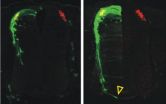(Press-News.org) You detect an object flying at your head. What do you do? You probably first move out of the way -- and then you try to determine what the object is. Your brain is able to quickly switch from detecting an object moving in your direction to determining what the object is through a phenomenon called adaptation.
A new study in the Nov. 21 advance online edition of the journal Nature Neuroscience details the biological basis of this ability for rapid adaptation: neurons located at the beginning of the brain's sensory information pathway that change their level of simultaneous firing. This modification in neuron firing alters the nature of the information being relayed, which enhances the brain's ability to discriminate between different sensations -- at the expense of degrading its ability to detect the sensations themselves.
"Previous studies have focused on how brain adaptation influences how much information from the outside world is being transmitted by the thalamus to the cortex, but we show that it is also important to focus on what information is being transmitted," said Garrett Stanley, an associate professor in the Wallace H. Coulter Department of Biomedical Engineering at Georgia Tech and Emory University.
In addition to Stanley, Coulter Department research scientist Qi Wang and Harvard Medical School Neurobiology Department research fellow Roxanna Webber contributed to this work, which is supported by the National Institutes of Health.
For the experiments, Stanley and Wang moved a rat's whisker to generate a sensory input. Moving whiskers at different speeds or at different angles produced sensory inputs that could be discriminated. This sensory experience is analogous to an individual moving a fingertip across a surface and perceiving the surface as smooth or rough. While the whiskers were being moved, the researchers recorded neural signals simultaneously from different parts of the animal's brain to determine what information was being transmitted.
"Neuroscientists know a lot about different parts of the brain, but we don't know a lot about how they talk to each other. Recording how neurons are simultaneously communicating with each other in different parts of the brain and studying how the communication changes in different situations is a big step in this field," said Stanley.
The results from the experiments showed that adaptation shifted neural activity from a state in which the animal was good at detecting the presence of a sensory input to a state in which the animal was better at discriminating between sensory inputs. In addition, adaptation enhanced the ability to discriminate between deflections of the whiskers in different angular directions, pointing to a general phenomenon.
"Adaptation differentially influences the thalamus and cortex in a manner that fundamentally changes the nature of information conveyed about whisker motion," explained Stanley. "Our results provide a direct link between the long-observed phenomenon of enhanced sensory performance with adaptation and the underlying neurophysiological representation in the primary sensory cortex."
The thalamus serves as a relay station between the outside world and the cortex. Areas of the cortex receive and process information related to vision, audition and touch from the thalamus.
The study also revealed that information the cortex receives from the thalamus is transformed as it travels through the pathway due to a change in the level of simultaneous firing of neurons in the thalamus. The researchers found that the effect of adaptation on the synchrony of neurons in the thalamus was the key element in the shift between sensory input detection and discrimination.
"There is a switching of the circuit to a different function. The same neurons do two different things and switch quickly, in a matter of seconds or milliseconds, through a change in the synchronization across neurons," explained Stanley. "If we think of the neurons firing like members of an audience clapping hands, then the sound of the clapping becomes louder when they all clap together."
In the future, the techniques used in this study may be valuable for probing the effects of brain injury on this pathway and others, as a variety of different diseases and disorders act to change the degree of synchronization of neurons in the brain, resulting in harmful effects.
INFORMATION:
This project is supported by the National Institutes of Health (NIH) (Award No. R01NS48285). The content is solely the responsibility of the principal investigator and does not necessarily represent the official view of the NIH.
Study reveals neural basis of rapid brain adaptation
2010-11-23
ELSE PRESS RELEASES FROM THIS DATE:
Fall bonefish census sounds warning bell that warrants careful future monitoring
2010-11-23
MIAMI – November 22, 2010 – This October more than 60 guides and anglers in the Florida Keys poled across the flats from Biscayne Bay to the Marquesas, assisting in the annual bonefish census. This year's count, held in extremely difficult weather with lowered visibility, was down by 25-percent from an 8-year mean estimate of 316,805 bonefish to a new low of about 240,000 bonefish, according to Professor Jerry Ault, a fisheries scientist with the University of Miami's Rosenstiel School of Marine & Atmospheric Science.
"Since 2003 we have conducted an annual bonefish ...
Flexible wings driven by simple oscillation may be viable for efficient micro air vehicles
2010-11-23
In the future, tiny air vehicles may be able to fly through cracks in concrete to search for earthquake victims, explore a contaminated building or conduct surveillance missions for the military. But today, designing the best flying mechanism for these miniature aerial machines is still a challenging task.
Creating micro-scale air vehicles that mimic the flapping of winged insects or birds has become popular, but they typically require a complex combination of pitching and plunging motions to oscillate the flapping wings. To avoid some of the design challenges involved ...
Putting the squeeze on fat cells
2010-11-23
From fad diets to exercise programs, Americans continue to fight the battle of the bulge. Now they'll have help from recent Tel Aviv University research that has developed a new method to look at how fat cells -- which produce the fat in our bodies -- respond to mechanical loads.
This might be the key to understanding how to control the amount of fat produced by fat cells, the holy grail of weight loss researchers, says Prof. Amit Gefen of Tel Aviv University's Department of Biomedical Engineering. His research is driven by the theory that fat cells, like bone or muscle ...
Scientists clock on to how sunlight shapes daily rhythms
2010-11-23
Fresh insight into how biological clocks adjust to having less sunlight in the winter could help us better understand the impact of jet lag and shift work.
Scientists studying the daily activity cycle in plants – known as circadian rhythms – have discovered a finely tuned process that enables the plant's genes to respond to the times of dawn and dusk each day, as well as the length of daylight in between.
This system helps the plant to reset its internal clock every day in response to seasonal changes in daylight, which helps the plant control the timing of key activities ...
Bacteria help infants digest milk more effectively than adults
2010-11-23
Infants are more efficient at digesting and utilizing nutritional components of milk than adults due to a difference in the strains of bacteria that dominate their digestive tracts. Researchers from the University of California, Davis, and Utah State University report on genomic analysis of these strains in the November 2010 issue of the journal Applied and Environmental Microbiology identifying the genes that are most likely responsible for this difference.
"Human milk oligosaccharides (HMOs) are the third-largest solid component of milk. Their structural complexity ...
Hong Kong hospital reports possible airborne influenza transmission
2010-11-23
Direct contact and droplets are the primary ways influenza spreads. Under certain conditions, however, aerosol transmission is possible. In a study published in the current issue of Clinical Infectious Diseases, available online (http://www.journals.uchicago.edu/doi/abs/10.1086/656743), the authors examined such an outbreak in their own hospital in Hong Kong.
On April 4, 2008, seven inpatients in the hospital's general medical ward developed fever and respiratory symptoms. Ultimately, nine inpatients exhibited influenza-like symptoms and tested positive for influenza ...
Researchers kick-start ancient DNA
2010-11-23
BINGHAMTON, NY – Binghamton University researchers recently revived ancient bacteria trapped for thousands of years in water droplets embedded in salt crystals.
For decades, geologists have looked at these water droplets — called fluid inclusions — and wondered whether microbes could be extracted from them. Fluid inclusions have been found inside salt crystals ranging in age from thousands to hundreds of millions years old.
But there has always been a question about whether the organisms cultured from salt crystals are genuinely ancient material or whether they are ...
MU scientist develops salmonella test that makes food safer, reduce recalls
2010-11-23
VIDEO:
University of Missouri researchers have created a new test for salmonella in poultry and eggs that will produce faster and more accurate results than most currently available tests.
Click here for more information.
COLUMBIA, Mo. –Earlier this year, an outbreak of salmonella caused by infected eggs resulted in thousands of illnesses before a costly recall could be implemented. Now, University of Missouri researchers have created a new test for salmonella in poultry ...
Cutting-edge salivary diagnostics research presented at AADR 3rd Fall Focused Symposium
2010-11-23
Alexandria, Va. – The American Association for Dental Research (AADR) held its 3rd Fall Focused Symposium on November 12-13, in the Washington, DC, area. This year, the theme was the fast-moving field of Salivary Diagnostics, with a focus on Scientific & Clinical Frontiers. The symposium was sold-out, but AADR also offered a live Webinar broadcast of the oral sessions.
AADR created the Fall Focused Symposium under the objective to provide networking opportunities and exchange of ideas, and to offer small regional symposia focused on cutting-edge technology and techniques. ...
Speed heals
2010-11-23
Both the rate and direction of axon growth in the spinal cord can be controlled, according to new research by USC College's Samantha Butler and her collaborators.
The study, "The Bone Morphogenetic Protein Roof Plate Chemorepellent Regulates the Rate of Commissural Axonal Growth," by Butler; lead researcher Keith Phan and graduate students Virginia Hazen and Michele Frendo of USC College; and Zhengping Jia of the University of Toronto, was published online in the November 17 issue of the Journal of Neuroscience.
Butler, assistant professor of biological sciences, found ...





